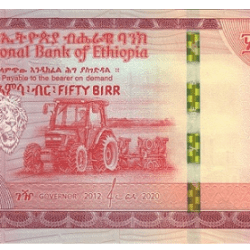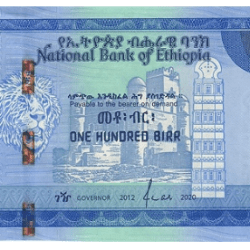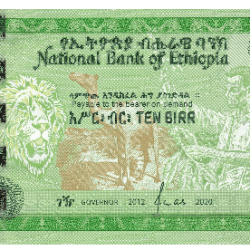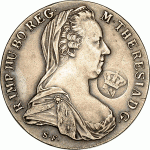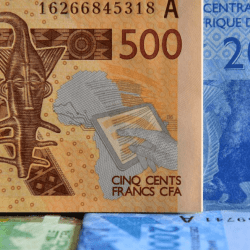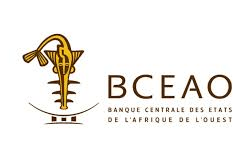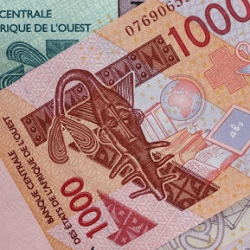200 Birr is one of the denominations of Ethiopian currency notes. Other denominations of Birr are: 10, 50, and 100 banknotes. Coins are: 1, 5, 10, 25 and 50.
Birr subdivides into 100 santims.
200 Birr
| Value | Obverse | Reverse |
|---|---|---|
| 200 birr | Pigeon | Capricorn |
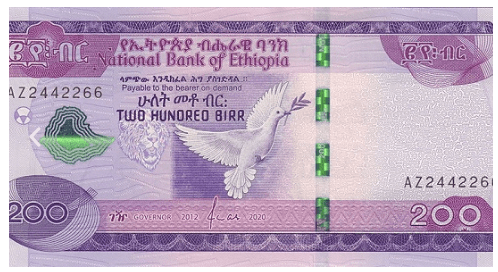
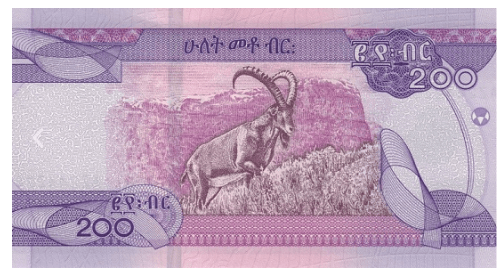
Birr notes
Birr is the official currency of Ethiopia. It subdivides into 100 santims. Birr comes in denominations of 10, 50, 100, and 200 banknotes and 1, 5, 10, 25, 50 coins.
The currency code for Birr is ETB and the currency symbol is Br.
On September 14, 2020, new currency notes were introduced. The new currency notes replaced the 10, 50 and 100 notes while an additional 200 birr note was introduced.
100 Birr
| Value | Obverse | Reverse |
|---|---|---|
| 100 birr | Enqulal Gemb fortress (Gondar) | Sof Omar caves; City gate, Harar |
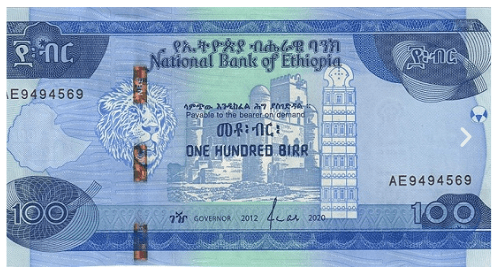
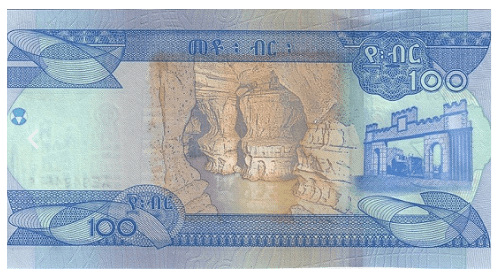
50 Birr
| Value | Obverse | Reverse |
|---|---|---|
| 50 birr | Tractor | Factory |
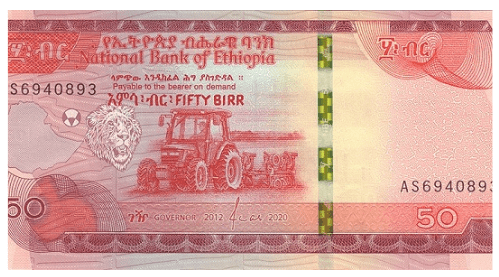
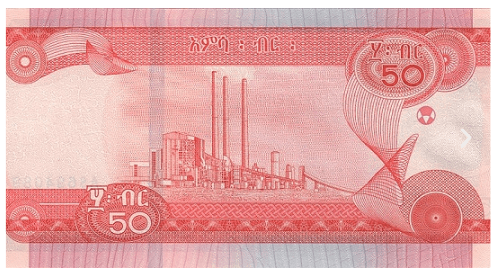
10 Birr
| Value | Obverse | Reverse |
|---|---|---|
| 10 birr | Camel, coffee harvest | Two couples |
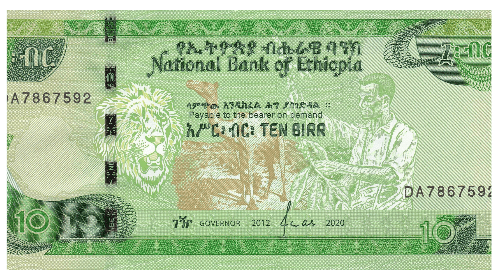

Description of the Ethiopian birr banknotes
| Value | Obverse | Reverse |
|---|---|---|
| 10 birr | Camel, coffee harvest | Two couples |
| 50 birr | Tractor | Factory |
| 100 birr | Enqulal Gemb fortress (Gondar) | Sof Omar caves; City gate, Harar |
| 200 birr | Pigeon | Capricorn |
National Bank of Ethiopia
The National Bank of Ethiopia is the country’s central bank.
It’s the federal government banker and the regulator of the banking industry in the country.
Location: Addis Ababa, Ethiopia
Tel: +251 115 517430
Fax: +251 115 514588
Email: nbe.excd@telecom.net.et
P.O. Box: 5550

The National Bank of Ethiopia was established in 1963 by proclamation 206 of 1963 and began operation in January 1964.

The National Bank of Ethiopia was established in 1963 by proclamation 206 of 1963 and began operation in January 1964. Prior to this proclamation, the Bank used to carry out dual activities, i.e. commercial banking and central banking.
The proclamation raised the Bank’s capital to Ethiopian dollars 10.0 million and granted broad administrative autonomy and juridical personality. Following the proclamation the National Bank of Ethiopia was entrusted with the following responsibilities.
- To regulate the supply, availability and cost of money and credit.
- To manage and administer the country’s international reserves.
- To license & supervise banks & hold commercial banks reserves & lend money to them.
- To supervise loans of commercial banks and regulate interest rates.
- To issue paper money and coins.
- To act as an agent of the Government.
- To fix and control the foreign exchange rates.
However, monetary and banking proclamation No. 99 of 1976 came into force on September 1976 to shape the Bank’s role adoring to the socialist economic principle that the country adopted. Hen e the Bank was allowed to participate actively in national planning, specifically financial planning, in cooperation with the concerned state organs.
The Bank’s supervisory area was also increased to include other financial institutions such as insurance institutions, credit cooperatives and investment-oriented banks. Moreover the proclamation introduced the new Ethiopian currency called ‘birr’ in place of the former Ethiopia Dollar that eased to be legal tender thereafter.
The proclamation revised the Bank’s relationship with Government. It initially raised the legal limits of outstanding government domestic borrowing to 25% of the actual ordinary revenue of the government during the proceeding three budget years as against the proclamation 206/1963, which set it to be 15%.
This proclamation was in force till the new proclamation issued in 1994 to reorganize the Bank according to the market-based economic policy so that it could foster monetary stability, a sound financial system and such other credit and exchange conditions as are conducive to the balanced growth of the economy of the country. Accordingly the following are some of the powers and duties vested in the Bank by proclamation 83/1994.
- Regulate the supply and availability of money & credit and applicable interest and other changes.
- Set limits on gold and foreign exchange assets which banks and other financial institutions authorized to deal in foreign exchange an hold in deposits.
- Set limits on the net foreign exchange position and on the terms and amount of external indebtedness of banks and other financial institutions.
- Make short and long-term refinancing facilities available to banks and other financial institutions.
Moreover, the proclamation has also raised the paid-up capital of the Bank from Birr 30.0 million to Birr 50.0 million.
The agreement that was reached in 1905 between Emperor Minilik II and Mr. Ma Gillivray, representative of the British owned National Bank of Egypt marked the introduction of modern banking in Ethiopia.
Following the agreement, the first bank called Bank of Abysinia was inaugurated in Feb.16, 1906 by the Emperor.
The Bank was totally managed by the Egyptian National Bank and the following rights and concessions were agreed upon the establishment of Bank of Abyssinia
Reference: nbe.gov.et
List of Banks in Ethiopia
Ethiopia has numerous banks, namely:
- Awash International Bank
- Commercial Bank of Ethiopia
- Development Bank of Ethiopia
- Dashen Bank
- Wegagen Bank
- Bank of Abyssinia
- Hibret Bank
- Nib International Bank
- Cooperative Bank of Oromia
- Lion International Bank
- Zemen Bank
- Oromia Bank
- Bunna International Bank
- Berhan International Bank
- Abay Bank S.C
- Addis International Bank S.C
- Debub Global Bank S.C
- Enat Bank S.C
- ZamZam Bank S.C
- Goh Betoch Bank S.C
- Hijira Bank S.C
- Siinqee Bank S.C
- Shabelle Bank S.C
- Ahadu Bank S.C
- Tsedey Bank S.C
- Amhara Bank S.C
- Gadaa Bank S.C
- Sidama Bank S.C
- Rammis Bank S.C
- Omo Bank Share Company
- Tsehay Bank Share Company
More on Ethiopia
The Federal Democratic Republic of Ethiopia is an African country.
It shares borders with Eritrea to the north, Djibouti to the northeast, Somalia to the east and southeast, Kenya to the south, South Sudan to the west, and Sudan to the northwest.
Addis Ababa is the capital and largest city.

Languages: Amharic, Oromo, Somali, Tigrigna, Afar …
Dialing code: +251
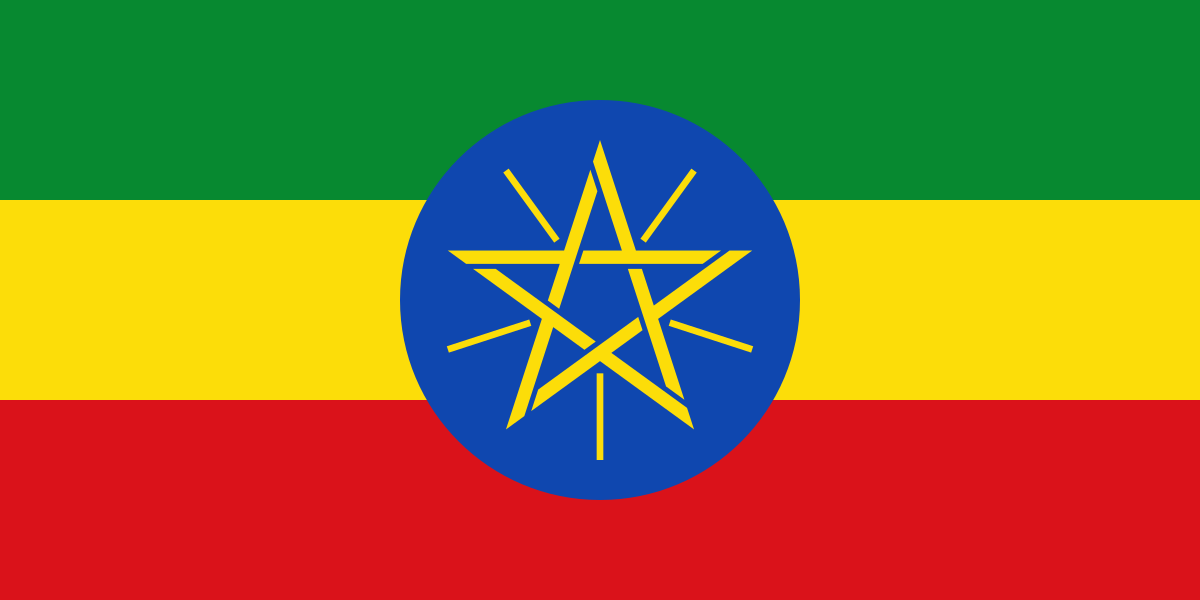
As of 2023 the country’s population was 107,334,000, making it the 13 most populated country in the world and 2 most populated in Africa after Nigeria.
It covers a land area of 1,112,000 square kilometres (472,000 sq. miles).

Ethiopia is multi-ethnic with over 80 different ethnic groups. Oromo and Amhara are the country’s two largest ethnic groups.
Christianity is the most widely professed faith in the country. The country has some adherents of Islam and other faiths.
Regions
Ethiopia is administratively divided into four levels: regions, zones, woredas (districts) and kebele (wards).
The first level administrative division in Ethiopia is a region, also called kilil, or alternatively regional state.
The 1995 Constitution of Ethiopia established the regions based on ethno-linguistic territories.
The country comprises 11 regions and two city administrations under these regions, many zones, woredas and neighbourhood administration: kebeles.
Previously, this level was called a province, and though many of the old province and new region names are the same, the entities are not identical and the words region and province are not interchangeable. As of 2022 there were eleven regions.
The regions and their capitals in Ethiopia are as follows:
- Addis Ababa (City) …. Addis Ababa
- Afar Region … Semera
- Amhara Region … Bahir Dar
- Benishangul-Gumuz Region … Asosa
- Dire Dawa (City) … Dire Dawa
- Gambela Region … Gambela
- Harari Region … Harar
- Oromia Region … Addis Ababa
- Sidama Region … Hawassa
- Somali Region … Jijiga
- South West Ethiopia Peoples’ Region … Bonga
- Southern Nations, Nationalities, and Peoples’ Region … Hawassa
- Tigray Region … Mek’ele
Zones
Regions are subdivided into zones. The number of zones varies, but most regions have around six to twelve zones.
The largest region Oromia has over 20 zones, and the two smallest regions have none.
There are some cities which are set up as “special zones”, such as Bahir Dar Special Zone in the Amhara Region.
The earlier equivalent to a zone was called an awrajja, and many zones today are named the same as their earlier awrajja, but the terms zone and awrajja are not interchangeable.
Woredas
Zones are divided into woredas (districts). In Ethiopia, the woredas comprise three main organs: a council, an executive and a judicial.
The Woreda Council is the highest government organ of the district, which is made up of directly elected representatives from each kebele in the woredas.
The representative of the people in each kebele is accountable to their electorate.
Kebele
Woredas are divided into kebele, municipalities. Each kebele comprises around 20 smaller villages.
Kebele is the smallest administrative division. This is sometimes also called tabia or tabiya. They are at the neighborhood level and are the primary contact for most citizens living in Ethiopia. Their administrative unit consists of an elected council, a cabinet (executive committee), a social court and the development and security staff. Kebeles are accountable to their woreda councils and are typically responsible for providing basic education, primary health care, agriculture, water, and rural roads.

